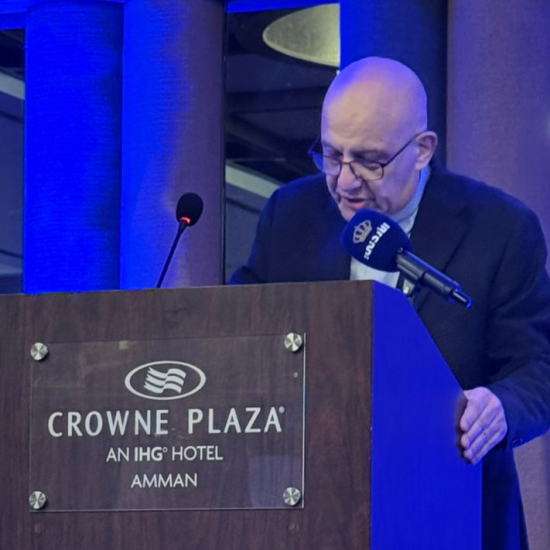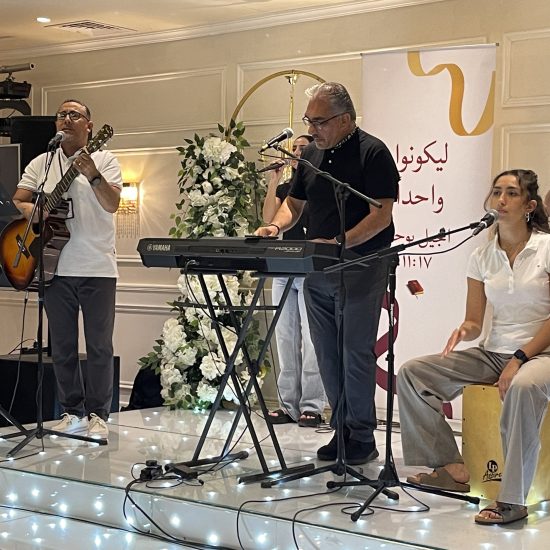Jordan is a Middle Eastern jewel that from a distance doesn’t seem to sparkle quite as brightly as some places in this part of the world.
Jordan is not blessed with expansive oil reserves like several other Arab nations. By their standards, it is a relatively poor Arab country. The Hashemite Kingdom of Jordan, as it is officially known, is slightly smaller than Missouri. The current population is about 7.3 million.

Jordan: Where John baptized, the Hebrew exiles wandered and Moses caught a glimpse of the Promised Land. (Photo by Tom Tracy, The Florida Catholic)
|
King Abdullah II, 52, ascended to the throne of this monarchy in 1999 when his father, longtime monarch King Hussein, died. The royal family is Hashemite by virtue of being descended from Hashim, great-grandfather of Mohammed.
Arab hospitality is at its best in Jordan, and refugees fleeing regimes and unrest in the adjacent Middle East have long found the kingdom to be a welcome refuge.
For more than three years, Syrians fleeing the civil war in their nation have flooded Jordan, as well as Lebanon and other countries, in pursuit of safety and security for themselves and their families.
The U.N. High Commissioner for Refugees expects the number of Syrian refugees in Jordan alone to increase by as much as 33 percent to up to 800,000 by the end of 2014. The U.N. reports 120,000 Syrians reside in the Zaatari refuge camp near the northern border across from southern Syria but the vast majority of refugees are in non-camp situations.
Similar influxes of refugees and immigrants from Iraq, Iran, Turkey and Israel’s West Bank through the years have increasingly challenged Jordan’s economy and stretched its infrastructure’s ability to provide basic services like electricity, water, waste management, education and health care. Historically, large numbers of refugees never leave Jordan and are assimilated into the population. Refugees with some wealth often stay and invest in commercial ventures like the Jordanian capital of Amman, which dates to Neolithic times. A guide points to a gleaming office building of 15-20 stories nearing completion and attributes it to Iraqi developers.
Tourism
Tourism is certainly not as highly developed as in Israel, Jordan’s next-door neighbor to the west. Nor is it nearly as profitable for a nation that really needs for tourism to become a financial boon.
As a destination, Jordan attracts an increasing amount of interest these days. Its stock is on the rise among Holy Land and other tour operators.
Traditionally a short add-on to Bibleland tours to Israel, today the moderate Arab nation increasingly stands on its own as a destination for travelers from several parts of the world who come for various reasons.
Visitors find lodging at various levels of expense and comfort; full-service high-end hotels have sprung up in downtown Amman, the seat of culture and commerce; along the Dead Sea with its healing waters and therapeutic spas; near Petra, the carved-into-stone city recognized as one of the wonders of the world; and at Aqaba, Jordan’s only coastal city and a Red Sea watersports resort at Jordan’s southern tip.
Petra — the stone city
Declared one of the new Seven Wonders of the World by a worldwide popular vote promotion in 2007, Petra is Jordan’s No. 1 tourist attraction.
The city carved out of red sandstone by the Nabateans sometime in the third or fourth century B.C., Petra literally attracts people from all over the world who gaze in wonder at multi-story structures, most of them designed to honor the dead. The Nabatean civilization existed for 1,000 years.
Today, visitors don hiking shoes and comfortable clothing as they brave heat and trek long distances through the siq, a walkway between imposing cliffs and huge shards of sandstone en route to the breathtaking heart of Petra. In some ways, modern-day Petra is similar to what the spectacle might have looked like when it sat on ancient trade routes.
Locals offer camel and donkey rides and horse-drawn carriage transportation into and out of Petra for a negotiated fee. The animals and their keepers proliferate, much like they probably did as caravans came from different directions to conduct trade and marvel at Petra’s wonders two millennia ago.
Many of today’s entrepreneurs are dressed like their predecessors might have in the trading center’s heyday.
Enclosed by towering rocks and watered by a perennial stream, the fortress-like city helped Nabateans control the main commercial routes that passed through it from many directions. They devised a system for collecting water, growing crops and sustaining their population, estimated to number 30,000 residents at one time.

Decorated sand bottles with intricate renditions of animals, people and landscapes are popular souvenirs for travelers to Jordan. (Photo by Tom Tracy, The Florida Catholic)
|
Interspersed between Nabatean structures these days are rustic souvenir and refreshment shops and public restrooms. T-shirts and souvenir caps abound as tired tourists kick through sand collecting on the site’s walkways and fight off the sun’s heat. Petra bustles today with international visitors, locals and their animals and uniformed officers.
The star of the expansive collection of structures is the one people think of first when Petra is mentioned — the Treasury. It is an imposing edifice with statuary, columns, urns and other visual elements amazingly carved in relief out of the side of a rock mountain.
Wadi Rum — the desert
Nowhere is Jordan’s natural landscape more spectacular than in the southern desert valley of Wadi Rum — “Valley of the Moon” — still familiar to many westerners as the site of the filming of the epic Oscar-winning movie “Lawrence of Arabia” (1962) starring the late Peter O’Toole.
Inhabited by Bedouins — who mastered living in the harsh, hot, arid climate of the valley covered by sand dunes and rock formations — Wadi Rum attracts visitors who take trips across the expansive landscape in small pickup trucks that swerve through and bounce across the sand, their beds equipped with bench seats and tarps for shade.
Such cross-desert rides are bumpy and certainly test the shocks of the small Toyota trucks. Tourists see Bedouins herding their camels and observe inhabited tent homes nestled against rock walls.
As they make stops, drivers serve hot tea to travelers after they scurry up rock formations to discover panoramic views of the epic landscape, pose with drivers and guides in native dress and take photos of rock formations, each other and dramatic sunsets.
Visitors also can camp, ride camels, enjoy sumptuous Middle Eastern meals enhanced with an array of fresh fruits and vegetables and ride hot-air balloons to gain an even more breathtaking view of what seems like an endless desert valley. Resort camps give tourists a taste of the Bedouin life.
These rustic tourist venues are still intimate and cater to small groups of tourists. Jordanians, both tourism entrepreneurs and local residents, consistently express hospitality. That is true just about everywhere a visitor ventures in Jordan.

This young Jordanian artist hones her skills at making intricate mosaic art at a shop in Madaba, Jordan. (Photo by Tom Tracy, The Florida Catholic)
|
The nation’s borders touch not only Israel to the west but Syria to the north, Iraq to the east and Saudi Arabia to the east and south.
Roman ruins proliferate in places like Um Qais and Jerash in the north and in many other areas of Jordan. They attest to the strategic importance Rome placed on particular outposts and population centers.
Today, the remains of ancient Byzantine churches sit in close proximity to columns and places important to the Romans.
Archeological digs continue, and efforts to preserve antiquities are endorsed and carried out by the government. They produce tourist traffic and income.
Virtually everywhere ruins exist, such as those in Jerash, today’s visitors are free to venture inside structures or walk along large-stone streets that remain pretty well intact but are not very navigable for modern-day vehicles.
Few, if any, ruins are off limits to tourists as westerners might expect. Most can be touched or even climbed. Visitors can take their seats of choice in remains of amphitheaters popular among Romans for speaking and entertainment venues.
A visitor can easily imagine experiencing what a Roman might have witnessed on-stage during the first century.
The same is true of such Roman artifacts as mosaics, usually covering floors or decorating walls in ancient Roman buildings.
Madaba is known for producing modern-day art using the ancient skill of connecting small pieces of colored stone to form such things as table surfaces, framed art and other objects.
The area attracts skilled artisans at renditions of the ancient craft. Their work populates galleries and tourist shops.






